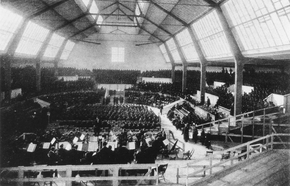| Symphony No. 8 | |
|---|---|
| "Symphony of a Thousand" | |
| Choral symphony by Gustav Mahler | |
 Final rehearsal for the world premiere in the Neue Musik-Festhalle in Munich | |
| Key | E-flat major |
| Text |
|
| Composed | 1906 |
| Movements | 2 |
| Premiere | |
| Date | 12 September 1910 |
| Conductor | Gustav Mahler |
| Performers | Munich Philharmonic |
The Symphony No. 8 in E-flat major by Gustav Mahler is one of the largest-scale choral works in the classical concert repertoire. As it requires huge instrumental and vocal forces it is frequently called the "Symphony of a Thousand", although the work is normally presented with far fewer than a thousand performers and the composer disapproved of the name. The work was composed in a single inspired burst at his Maiernigg villa in southern Austria in the summer of 1906. The last of Mahler's works that was premiered in his lifetime, the symphony was a critical and popular success when he conducted the Munich Philharmonic in its first performance, in Munich, on 12 September 1910.
The fusion of song and symphony had been a characteristic of Mahler's early works. In his "middle" compositional period after 1901, a change of style led him to produce three purely instrumental symphonies. The Eighth, marking the end of the middle period, returns to a combination of orchestra and voice in a symphonic context. The structure of the work is unconventional: instead of the normal framework of several movements, the piece is in two parts.[n 1] Part I is based on the Latin text of Veni creator spiritus ("Come, Creator Spirit"), a ninth-century Christian hymn for Pentecost, and Part II is a setting of the words from the closing scene of Goethe's Faust. The two parts are unified by a common idea, that of redemption through the power of love, a unity conveyed through shared musical themes.
Mahler had been convinced from the start of the work's significance; in renouncing the pessimism that had marked much of his music, he offered the Eighth as an expression of confidence in the eternal human spirit. In the period following the composer's death, performances were comparatively rare. However, from the mid-20th century onwards the symphony has been heard regularly in concert halls all over the world, and has been recorded many times. While recognising its wide popularity, modern critics have divided opinions on the work; Theodor W. Adorno, Robert Simpson, and Jonathan Carr found its optimism unconvincing, and considered it artistically and musically inferior to Mahler's other symphonies. Conversely, it has been compared by Deryck Cooke to Ludwig van Beethoven's Symphony No. 9 as a defining human statement for its century.
Cite error: There are <ref group=n> tags on this page, but the references will not show without a {{reflist|group=n}} template (see the help page).